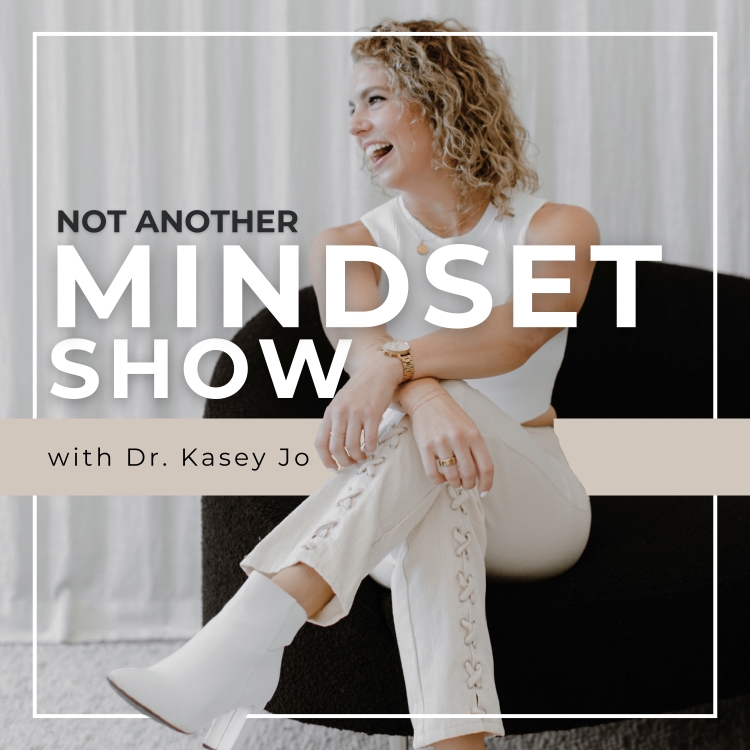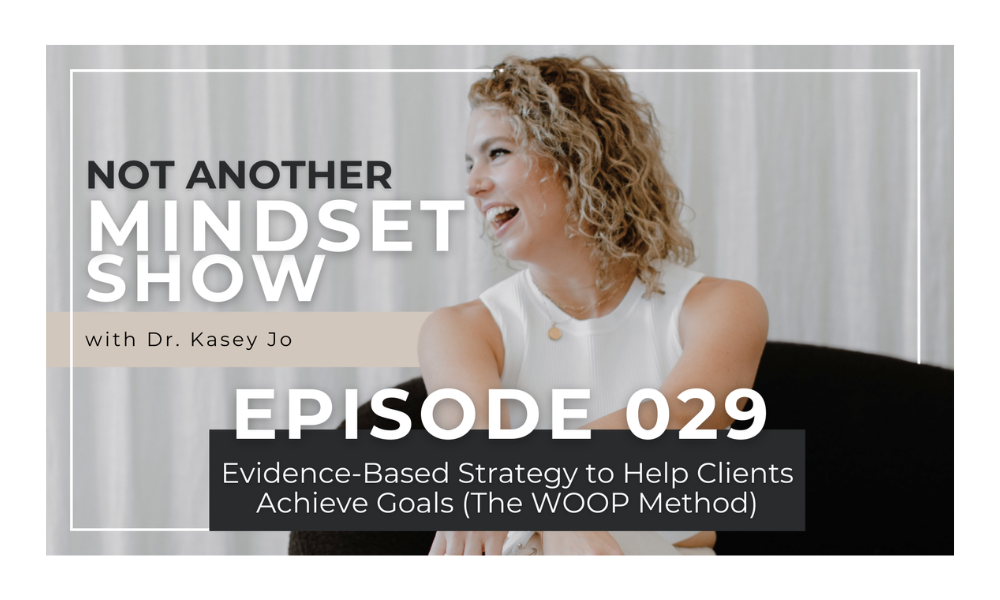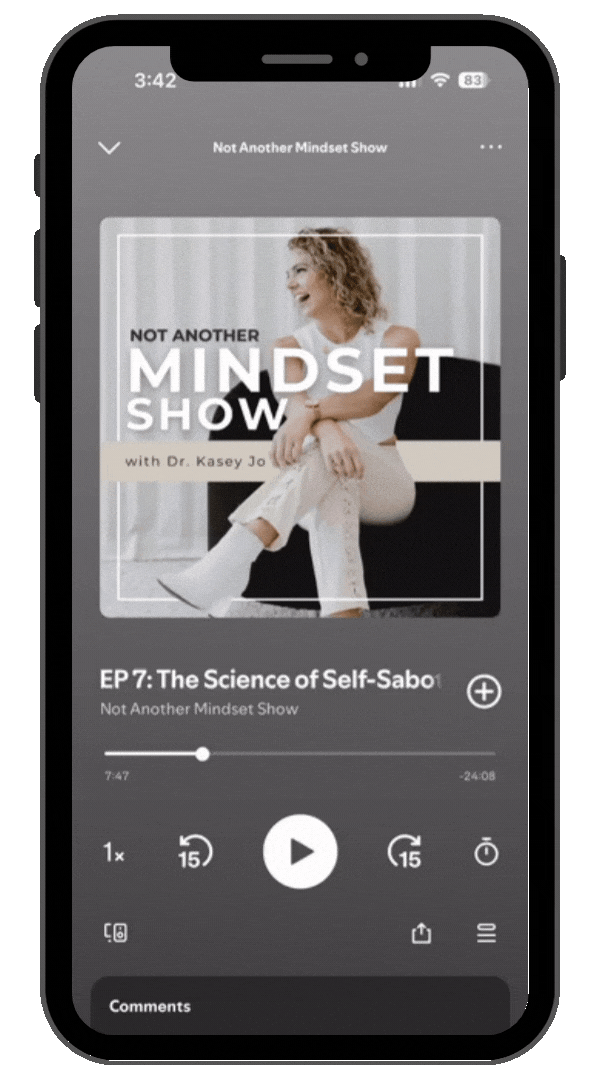The motivation techniques to help your clients be more successful.
Start helping your clients achieve behavior change with my 5 FREE lessons in behavior change and mindset. These lessons will help you coach your clients to overcome all-or-nothing thinking and fixed mindset, stop self-sabotage, develop more self-control, and increase motivation and follow-through.
Interested in a science-backed framework to help your clients achieve goals in fitness, wellness, and other areas of their lives?
In this episode, I do a deep dive into the evidence-based WOOP method that health coaches can use to help clients identify their goals and obstacles and achieve their desired outcomes. I share how you can implement this research-backed method in your coaching practice.
Use the WOOP method beyond fitness coaching to help achieve personal growth and even achieve professional goals.
Episode highlights
>>(2:13) Positive visualization is missing one critical step to help you achieve your goals.
>>(3:49) Evidence-based tactics to achieve your goals recommend starting with goal clarity.
>>(4:39) Visualizing the outcome to help achieve your goals.
>>(5:09) What most people forget when they practice visualization is thinking of the obstacles.
>>(5:57) The importance of having a plan to go from wish to goal success.
>>(6:36) Why the WOOP method works to help people achieve their goals.
>>(8:37) Mental contrasting between where you are now and where you want to go.
>>(11:59) Walking through how to use the WOOP method in your coaching practice.
Listen to the full episode to learn the WOOP method and how to apply this evidence-based goal achievement framework to your coaching practice.
Rate, review, and subscribe to my podcast.
If you enjoyed this episode, I’d be incredibly grateful if you could rate and review the show on your favorite platform. Your feedback helps me improve and allows others to discover the show. I want to hear from you whether you love the insights or have suggestions on how I can make the show even better!
Simply scroll down to the review section on Apple Podcasts, Spotify, or wherever you listen, and leave your thoughts. Your support means the world to me and helps me continue to bring you more of the content you enjoy.
Links From the Podcast
Episode 13: My SMARTER Goals Framework (And Why I Don’t Love the OG SMART Goals)
Health Mindset Coaching Certification Instagram
5 FREE lessons in mindset and behavior change coaching
Research mentioned: Oettingen, G. (2000). Expectation, Motivation, and Action. Journal of Personality and Social Psychology, 79(6), 1094-1109.
Research mentioned: Oettingen, G., Reininger, K., & Waller, H. (2012). “The impact of mental contrasting on exercise adherence: A randomized controlled trial.” Health Psychology, 31(2), 141-147.
Oettingen, G., & Wadden, T. A. (2014). “Using the WOOP method to promote weight loss: A randomized controlled trial.” Obesity, 22(2), 302-308.
Oettingen, G., & Gollwitzer, P. M. (2010). “Strategic implementation of goals: The role of mental contrasting and implementation intentions.” Personality and Social Psychology Bulletin, 36(2), 196-210.
Episode’s Full Transcript
Today we are talking about the WHOOP method, which is essentially like an effective goal setting, goal visualization strategy based in tons and tons and tons of research that we have on a concept called mental contrasting. And as we are getting into the new year, making our way into 2025, what the heck, This is really important and something that you’re going to want to consider with your clients and with yourself when it comes to determining how to approach your goals in the new year.
And we’re gonna do a whole episode on New Year’s resolutions and my take on them and why I actually think they are worth doing as much as, you know, I feel like popular media kind of makes us believe. But today we’re specifically talking about a method. A well validated method to help you achieve your goals and help your clients do the same.
So, visualization. Is something I feel like it’s talked about quite a lot and this idea of just visualizing the perfect outcome and how you want to feel and who you want to be and then sort of falls in like the manifestation space right and then that’s what’s going to kind of propel you to
I don’t love how much emphasis is actually placed on positive visualization and visualization tactics, strategies, whatever, because there’s a really, really big thing missing from that, from that in general, from visualization. And that is, zero focus on the fact that shit gets hard sometimes. You’re going to run into inevitable barriers and obstacles, things that are just throwing a wrench in all of your plans, and with visualization we’re not paying attention to any of those things.
So I don’t think that Visualization should be, like, disbarred. Like, that’s something that we should get rid of entirely. But I do think that there’s a better way to go about it, and from a scientific perspective, of course. So, the WOOP framework is wish, outcome, Obstacle and plan. Sounds sweet, simple, to the point, and it is, and it’s also really helpful when it comes to promoting motivation and action through this concept of mental contrasting.
So, I’m gonna walk through Each of those steps of wish, outcome, obstacle, plan. I always mess up the O’s in the middle. I have to think very hard before I get into it. And why it’s actually helpful because I also, just like with anything, I don’t want you just to listen to what I say and be like, okay, cool.
So I’m just going to go do this because Casey said to do it. I want you to have a full understanding as to why it’s effective in the first place. So with the W, the first step here, wish, this The essential purpose of this step is to enhance goal clarity. So, when we’re asking clients, asking ourselves to, like, articulate a very specific wish, the thing you want to achieve, how you really want it to look, That’s going to increase commitment to the goal because you’re very clear on that.
I have another podcast episode on, it’s not on smart goals setting, it’s more on a different framework that I like to use called Smarter Goals. So that’s a good place to start for this kind of wish perspective too, like what do you actually want? And then the outcome piece is where Visualization does actually have a place in the framework.
So, the outcome step encourages individuals to really vividly imagine. The benefits of achieving the goal, the positive emotions that come with it, and when doing all of that, it can really increase enthusiasm and motivation. So, again, I don’t dislike visualization. The problem is most people then stop there.
They stop at the wish and the outcome and then they just cross their fingers and hope it’s gonna happen, right? So, the next couple parts are really important. With obstacle. That’s the next, the O, the second O of the whoop, is helpful for just identifying barriers overall and kind of confronting and acknowledging the potential challenges that are going to arise on the way to that wish, to that outcome.
And if we don’t do those things, we’re not paying attention to those things. And when I say obstacles and barriers. I don’t just mean, you know, things in like the external world, but also internal barriers that could come up. If we’re not paying attention to that, then we’re going to get hit in the face when they, as they will, come along.
So at this point, It’s developing awareness around those obstacles and then starting to figure out what effective strategies could be to get through those obstacles. And then P is our final step, and that is for plan. We want to take our, our wish, our outcome, our obstacle, and turn it into something actually actionable.
So this empowers individuals to create concrete strategies for overcoming those obstacles, transforming those like somewhat abstract wishes and feelings into actionable steps, which obviously is going to help from a point of follow through. So So that is the WOOP framework, and that is why each step is important.
So here’s how it all actually works together. Encourages self reflection, which is so important, because if we have regular self reflection in our goal setting, goal monitoring, goal pursuit process, it’s going to really help everyone, help you, help your clients. to adjust plans as needed and maintain motivation over time if we’re continuing to kind of come back to this whoop method, right?
Also really helpful for just increasing resilience overall, preparing for challenges, developing contingency plans. People become more resilient when they know What’s ahead of them and they also have a plan of how to get through it. And of course it facilitates accountability. If you’re taking the time to really get clear on what that goal is, what you want from it, what’s going to get in the way of it, and have like a concrete plan.
Doesn’t that just sound so good? Um, it really does help to hold you accountable. And what’s great too, if you’re a coach listening to this, which I know many, many of you are, you also can help provide that accountability. And part of your accountability work can be through So I’m going to get into, like, some specifics of how this could look from a health and fitness coaching perspective so we could really have that clear application.
But of course I want to get into some science first. So I have a couple studies here that I want to walk through that I think provide a pretty solid foundation as to how this framework was developed and why you should actually even care. So this foundational study was from Audigen, I believe, is the last name of the researcher in, I know that’s the last name, I just like don’t know if I’m pronouncing it correctly.
And this was sort of like the, the foundational work to develop mental contrasting, which is where the WHOOP method was born out of. So in this study. They explored the concept of mental contrasting, which, again, mental contrasting is essentially this idea of contrasting the difference between where you are right now and where you want to go.
So we’re contrasting those things. And the key findings from this research was that people who engaged in mental contrasting were more likely to commit to their goals, take action, in comparison to those who only.
So this was a really important piece of work because essentially these researchers were saying the things that I was saying before, right? We can’t just visualize things. We need to, we need to go a little bit deeper. And there’s a lot of limitations when it comes to just leaning on purely positive thinking.
Individuals may feel motivated initially, but when it comes to actual sustained action over time, that’s where something like mental contrasting is most effective. So, the implications of this study has extended to many, many other areas beyond this one. So, Obviously, these researchers were like, cool, so where does this actually, where is this actually most beneficial?
And things like health behaviors, academic achievement, organizational settings, it’s everywhere. So, obviously, we’re going to talk about all this from a health and fitness perspective, but just know that this could work everywhere else too. For those of you that are business owners, you could think about it for yourself with your own business goals.
You could use it inside your team to help other team members get clear on their goals and work towards things. It’s, it really can be used everywhere, which is great. So, when it comes to goal achievement for health behaviors, specifically, we do have research on that as well. So, when it comes to weight loss, There’s research that supports using the WHOOP framework, and when they did so, those people were more successful in achieving their weight loss goals than those who relied on more traditional goal setting methods.
So that’s not to say. that other goal setting methods are not useful. This is the only one, right? But it is a tool that you should use if you’re trying to help clients lose weight. Exercise adherence was another study. And with this one, the WHOOP method has been shown to enhance exercise adherence. And those who set fitness goals using the WHOOP framework reported higher levels of motivation and commitment to their workout routines.
Love to see it, right? Uh, same thing with long term goal achievement. Studies indicate that people who consistently use the Woot method over time are more likely to achieve and maintain long term health behavior changes compared to those who don’t incorporate this framework. Okay, so I basically just said study after study after study to support the WOOP framework, but how can you actually use this in your coaching practices?
Because that’s what’s most important, right? I’m not just going to sit here, spew a bunch of research at you. The point is that you can actually leverage this stuff inside your coaching practices or with yourself. So I want to walk through an example of what this could actually look like. So with step one being wish, we want to take this time to define that very specific and meaningful goal for ourselves or for our clients.
So an example could be having, having a client who just wants to adopt healthier eating practices. And maybe that means incorporating just more fruits and vegetables over a period of time, like the next three months or something. So if that’s the wish, next we move to the outcome. So this is where the visualization piece can come in, right?
So. What would your client envision? And I would encourage you to ask them. If you visualize your life with this goal being achieved, how is it going to feel? Maybe they’ll say they feel more energized, they’re fitting into their clothes more comfortably, they’re receiving compliments, they’re enjoying their health behaviors, they’re enjoying eating healthier.
Really have them sort of like map that out. Maybe that’s like an exercise that you can have them do that they get back to you. Something like that. I actually really like with. The entire WHOOP framework, you could turn this into somewhat of like a, call it like a PDF or a worksheet or something like that to have clients fill out and then send back to you and you guys can have a discussion about it.
So step three is the obstacles. So we want to identify external and internal obstacles that might hinder So, maybe this client is realizing that one of their biggest obstacles is that they so frequently rely on, like, fast food or, like, unhealthy options because they feel that they’re easier, they’re less time consuming, etc.
So, If that’s an obstacle, and then maybe they also have like an internal obstacle of just feeling like they’ve never been able to be successful with inserting healthy behaviors into their life before, you need to know these things as a coach, right? So what’s the beauty of all of this? I mean, there’s, there’s so much beautiful about it, right?
Um, but having a client work through this stuff will then shed light for you as the coach to really understand What the client feels like their barriers are to success. Because you as the coach may think that you know what’s getting in the way of them seeing more success. And you, you may have a good idea, but we have to please keep in mind that you are not the expert on your client’s life.
And having them also be part of this goal setting process through WHOOP or through however you go about it. It’s really also going to help from an autonomy supportive perspective. And more autonomy, more autonomy equals more better than the more that we can help our clients feel autonomous and that they’re in control and they’re in the driver’s seat with all of this stuff, the better.
So lots of good stuff that comes with that third step going through the obstacles. And then finally, we get to plan. We get to create a concrete plan to overcome those identified obstacles and actually decide, like, how is this going to look? What is the actionable strategy here? So, again, this is an opportunity for you to have a conversation with your client.
I would not, would not suggest that you just go to them and say, Okay, well, based on your barriers, you should do this and you should do that and you should do this other thing. Instead, go to your client and say, Okay, based on the barriers, So I’m going to ask you a couple of questions that you shared and what you want to achieve.
How do you think this could actually play out? I have some ideas for you. But I’d love to hear some thoughts that you have first, and really have them be part of the process. That will also just lead them to feel more bought in to all of it as well, because they were the ones making the decision. It wasn’t you just telling them what to do.
As much as we think that’s what clients want, it’s not the best when it comes to long term behavior change. So, as I mentioned, you could package all of this up and put it into like a PDF or a worksheet, but there’s a lot of other ways that you could include the W, the O, the O, and the P into your coaching practices.
So, I think that this could be a really great place. to take the Woot! method and put it into, like, your onboarding processes, whether that’s, like, your intake forms or whatever that looks like. Maybe it’s an onboarding call with a new client. You guys can start to walk through those. Not only will it be helpful for them to actually achieve their goals, but it’s also going to make you look really good, because you have this evidence based strategy, this specific method to help your clients work through.
I also like the idea of taking the Woot! method and turning it into somewhat of like a workshop, whether that is for your, your team, if you are the head of a coaching team, you have assistant coaches, you have staff members doing something like that, especially at the start of the year, which is where we’re at, so hosting a workshop, or maybe it’s a, like a client wide, like a company wide workshop that you’re all doing together.
And another spot, I mean, there’s so many places, like, I really encourage you to get coaching. I’m not really creative of where this could fit in, but another place I think would be really powerful is to use this in sales calls, discovery calls, consult calls, whatever you call them. So with those very, very initial goal setting, goal discussions, those type of conversations with a prospective client.
Again, it’s going to make you look really good because you have this whole process that you want to talk with them about before they even become a client. So, and again, I think it will shed light a lot on that person for the future coaching relationship, the information that you really need to be. a great coach to that person.
And it’s also going to be really productive for that person. So even if they don’t end up working with you, they’re still going to take that and be able to run with it in their lives, which that’s what we’re here to do, right? Whether or not you actually take money from that person, you can still leave them with something that is helpful.
Okay, so we walked through the Whoop method, we talked about how it could play out in your coaching methods, we talked about where you could insert it into your coaching practices in different ways. If you have any questions, please don’t hesitate to reach out. I’d love to hear from you. But that is all I have for you on mental contrasting and the Whoop method.




